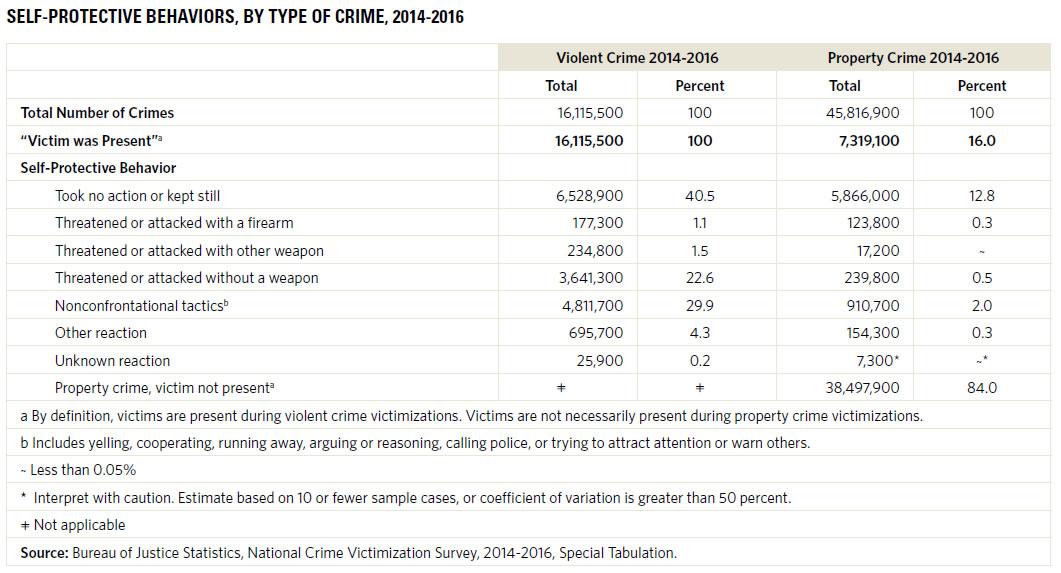Section Five: The Myth of Self-Defense Gun Use
While the centerpiece of the shared marketing strategy of the gun industry and NRA is the promotion of guns for self-defense, as noted at the beginning of this study, guns are rarely used to kill criminals or stop crimes.
As detailed in the 2020 Violence Policy Center study Firearm Justifiable Homicides and Non-Fatal Self-Defense Gun Use, in 2017, across the nation for all races and sexes, there were only 298 justifiable homicides involving a private citizen using a firearm reported to the Federal Bureau of Investigation’s Uniform Crime Reporting (UCR) Program as detailed in its Supplementary Homicide Report (SHR).75 That same year, there were 10,380 criminal gun homicides tallied in the SHR. In 2017, for every justifiable homicide in the United States involving a gun, guns were used in 35 criminal homicides. And this ratio, of course, does not take into account the tens of thousands of lives ended in gun suicides or unintentional shootings that year.
Of these 298 justifiable homicide incidents, 146 of the private citizens who used a firearm were Black (Hispanic ethnicity could not be determined because of the inadequacy of data reporting and collection). That same year, there were 7,809 Black homicide victims reported to the SHR. In 2017, for every time a Black American used a gun in a justifiable homicide, 53 Black lives were ended in homicides. And, once again, this ratio does not take into account Black lives lost in suicides or fatal unintentional shootings.
And while relatively few justifiable homicides are reported to the SHR, the question remains of how many times are guns used in non-lethal self-defense incidents. The most accurate survey of self-defense gun use is the National Crime Victimization Survey (NCVS) conducted by the Bureau of Justice Statistics. The survey has been ongoing since 1973. According to the NCVS, looking at the total number of self-protective behaviors undertaken by all victims of both attempted and completed violent crime for the three-year period 2014 through 2016, in only 1.1 percent of these instances had the intended victim in resistance to a criminal “Threatened or attacked with a firearm.” For the three-year period 2014 through 2016, the NCVS estimates that there were 16,115,500 victims of attempted or completed violent crime. During this same three-year period, only 177,300 of the self-protective behaviors involved a firearm. Of this number, it is not known what type of firearm was used or whether it was fired or not. The number may also include off-duty law enforcement officers who use their firearms in self-defense.

According to the NCVS, looking at the total number of self-protective behaviors undertaken by all victims of attempted or completed property crime for the three-year period 2014 through 2016, in only 0.3 percent of these instances had the intended victim in resistance to a criminal threatened or attacked with a firearm. For the three-year period 2014 through 2016, the NCVS estimates that there were 45,816,900 victims of attempted or completed property crime. During this same three-year period, only 123,800 of the self-protective behaviors involved a firearm. Of this number, it is not known what type of firearm was used, whether it was fired or not, or whether the use of a gun would even be a legal response to the property crime. And as before, the number may also include off-duty law enforcement officers. In comparison, a 2017 study estimated that there are approximately 250,000 gun theft incidents per year, with about 380,000 guns stolen.76 Further, according to the NCVS, there were 470,840 firearm victimizations in 2018 alone.77
Back to Table of Contents
Next – Conclusion
75 Firearm Justifiable Homicides and Non-Fatal Self-Defense Gun Use: An Analysis of Federal Bureau of Investigation and National Crime Victimization Survey Data, Violence Policy Center, May 2020 (https://vpc.org/studies/justifiable20.pdf).
76 Hemenway, D., Azrael, D., & Miller, M., “Whose guns are stolen? The epidemiology of Gun theft victims,” Injury Epidemiology, December 2017 (http://doi.org/10.1186/s40621-017-0109-8).
77 Morgan, Rachel and Oudekerk, Barbara, Criminal Victimization, 2018, Table 11, U.S. Department of Justice, Office of Justice Programs, Bureau of Justice Statistics, September 2019 (https://www.bjs.gov/content/pub/pdf/cv18.pdf).






